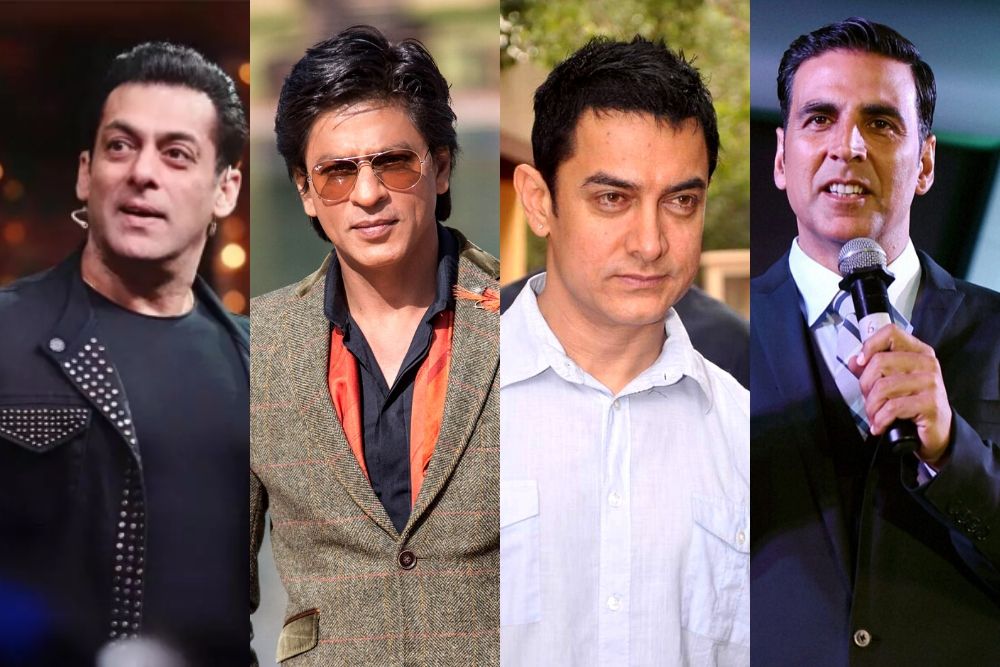Many people believe that the emergence of OTT platforms has reduced the number of moviegoers in cinema halls, but that’s not entirely true. The real reason for the Hindi film industry’s struggle with box office numbers is the diminishing influence of its stars, upon whom the industry has long relied to draw audiences. However, in 2023, the industry once again reaped benefits from its old practice of depending on star power when two seasoned stars delivered hits like ‘Jawaan,’ ‘Pathan,’ and ‘Animal.’ These films not only revived their careers but also reinstated the industry’s faith in the influence of stars, reinforcing their reliance on star power.

But is star power a bad thing if it attracts audiences and yields a blockbuster that ensures returns for investors, thereby keeping the industry running? Not at all. The real issue lies not in star power but in the everyday conversations which have no life of their own but exist only as side effects of star power. Our media and social media are inundated with such debates, and as citizens, we often find ourselves caught in a loop attempting to counter opinions that lead nowhere, ultimately diverting attention from the real problem.
If you haven’t guessed already, we are talking about ever-increasing debates on nepotism, pay disparity, the 100 crore club, and lack of originality. None of these factors are independent, and if you go to find their root cause, you will discover that one thing they all have in common is that they are only outcomes of the industry’s reliance on star powers and their ever-growing influence in the market.
It’s not that other film industries around the globe are not following similar practices, but it’s in the Hindi film industry where things are off balance. How did this happen? Not overnight; it took decades of cult and messiah worshiping and a mindset that considers films as a mindless medium, focusing solely on “entertainment, entertainment, and entertainment!”
Some of these factors alone have eliminated the space for experimentation and creativity in films. Whatever little space was left was obliterated by the business side of films. Because what any investor would want is a film that can ensure maximum return, and as a result, production houses prioritize securing popular actors.
And with big names at the center, everything revolves around them, money flows in their direction, leading to inappropriate distribution of funds. Also, these popular actors, when achieve the status of a star, rely more on their persona than on playing the character. Films are then designed to suit their persona, leaving little room for creativity and experimentation. This further leads to similar kinds of stories over and over again, as seen in most of Salman Khan’s movies in the last decade and SRK’s 2023 hits like ‘Jawan’ and ‘Pathan,’ making it a win-win situation for the audience as well as for the industry.
But then debates like nepotism, pay disparity, the 100 crore club, and lack of originality in content lose their value.
Let’s look at these topics independently and trace back their roots.
NEPOTISM
In the ongoing debate on nepotism, four key parties are at play: the star kids, the industry, the audience, and outsiders. External observers often criticize star kids and the industry for favoring familial connections over external talent, leading to the perceived neglect of individuals from outside the industry. It is undeniable that external talent faces additional challenges and disappointments on their journey to success.
However, can we solely blame star kids for this trend? The industry, driven by the need to produce more stars for the success of its films, seems to prioritize star power over a story-oriented approach. While a more balanced path could have been pursued, the allure of star influence has become a mutually beneficial arrangement for both the audience and the industry. The focus is on creating more stars, and who better to fill these roles than the children of established figures like SRK’s daughter or Amitabh Bachchan’s grandson? As an Indian audience, we find it more convenient and are more inclined to watch movies featuring familiar names rather than unknown faces. A prime example of this is evident in films like ‘Archies’; had it featured a completely new cast, many of us might not have given it a chance, even to discredit it later.

However, what often goes overlooked is the role of star kids in it. While they seem to be handed opportunities effortlessly, they are also products in the hands of the industry, which, in order to produce new stars for the next couple of decades, has a similar launchpad for all. While their individual talent could have demanded a different kind of story or opportunity within the industry, they are treated alike. The consequences are quite evident in the journey of most star kids, where after a couple of films, they look lost and struggle to find their ground within the industry.
So, the problem is not specific to any entity, but as a culture, what we have become and what we are celebrating, not knowingly, is a sure-shot recipe for the demise of creativity and talent within the industry.
100 CRORE CLUB
Although the 100 crore club does not catch as many eyeballs today as it used to, because it takes time for a film to reach this milestone. So came new tags that can catch instant attention, tags like opening day collections, weekend collections, and even the illustrious 500 crore club. However, it’s crucial to recognize that this concept originated around 2010, a pivotal period when a new generation of directors, including filmmakers like Anurag Kashyap and Dibakar Banerjee, took center stage in the film industry.

This era marked a shift in the industry’s landscape, creating space for experimental and offbeat films. Traditional, long-celebrated musicals began to recede, making way for movies with minimal background music, challenging conventional filmmaking norms. This shift provided a platform for experimentation and the emergence of new narratives. The term “100 crore club” was born during this transformative period, emphasizing the notion that certain films held greater popularity than others. This was a new way to establish the old rule. And that is when it all began; everyone wanted to be a part of this club, as it meant success.
Film magazines and news channels started talking about this new shift in the industry, and viewers once again started drifting towards the more popular films. Whether your film has a story or not, whether people like your film or not, what matters is whether your film is a part of this club or not. It has all become about numbers, and who can ensure numbers? Someone who can pull the crowd, who else? And so once again, the stories took a back seat, and star power was in its prime. This time, stars also became aware of their immense power and began a new race to become the highest-paid actor. And instead of their acting skills, their market price became the obsession, as it reflects the actor’s worth. The higher the price, the bigger the actor, and the greater the potential to draw audiences to the cinema hall.

It is important to note, that this whole practice was not done to stop anyone; it was just to reinstate one’s control by dictating whom to look for and who is the reigning actor of the time, reinstating star power and their influence in the market.
And so the practice continues, and with it, the decline of story-oriented films continues. As there can only be a few stars, and as we know, stars prefer to use their own persona over playing characters. Hence, story-oriented films and experimentation are for not-so-famous actors, who have no club at their service, which means not many eyeballs. Their voices get drowned amidst the noise of weekend collections and multi-crore clubs.
PAY PARITY
Lead actresses have often expressed their dismay over the significant disparity in their salary compared to their male counterparts in films. I feel this entire debate is a self-centered approach, and here’s why: the film is a collective medium involving writers, directors, technicians, and other cast and crew members who don’t receive their due share, primarily due to the star system. In this system, stars stand at the center of things, taking a larger chunk because the industry relies on them to draw the maximum audience to the theater.

Stating that women actors are unfairly treated is not entirely true because they are just one of the victims. There is no doubt about the immense power that male stars possess and their potential to deliver is far from any debate. However, what is often overlooked are other contributors to cinema who suffer the consequences of the star-centric approach. Women actors possess a voice and, being victims of this star system themselves, can adopt a broader view of the issue and direct attention to the underlying problem instead of using it to their own advantage.
The entire pay parity debate becomes irrelevant without the star system in place; it is merely a cause and effect of star power. The subsequent effect is a loss of content when other contributors know that their contributions will be hijacked or tailored to suit the needs of the top man in place. ‘Taare Zameen Par’ is a perfect example of how Aamir Khan, with his star power, took over the entire project from Amol Gupte, who was originally scheduled to direct the movie.
ORIGINALITY
Unlike many other debates, the potential of the Hindi film industry to create original work has been in question for a long time. To the extent that during college, we used to play a game where one person would name a song or a film, and others would have to guess where it is copied from, not inspired but taken. It’s evident how little of this has changed today.
At the time of writing this article, the industry has already shifted its focus towards South Indian films and filmmakers, mainly due to the recent box office success they have had with their films. Currently, the majority of movies we see in the Hindi film industry are either remakes of earlier hits, remakes of South Indian films, or action flicks directed by filmmakers from the South industry. Why this shift? With OTT platforms and global connectivity, copying international work is no longer a viable option, and acquiring the rights is an expensive route.
In this scenario, South Indian cinema, which already follows the star model, much like us but on steroids, seems like a surefire route to success. Two of the biggest hits in the Hindi film industry this year are given by South Indian directors starring Hindi film stars, and this model has worked like a charm for both the industry and the stars.

South Indian cinema has a different cinematic landscape. Their heroes are worshipped, and their larger-than-life cinema, no matter how nonsensical, is an eye-puller that garners box office numbers. They have mastered this art, and regardless of what anyone says, they remain original in their forms. Sadly, for an industry like ours, the unfortunate part is that we seem to have lost our own sense of cinema in the current times, relying on borrowed or remade content. When we observe an industry consistently delivering box office success at a time when our cinema halls were empty, we couldn’t help but adopt not just their model but also their filmmakers and technicians, combining them with our stars and their influence.
This whole approach is driven by an investment return outlook, with films being a risky investment, ensuring return is a priority, AT ANY COST. Currently, the content is paying the cost while stars are bringing the returns.



